
Retractable Fabric Awnings – Q and A The majority of self supporting awnings sold by Samson are made to measure, and therefore it is worth spending some time to make sure you order the best size possible for your application.The most important thing to consider is the fixing as there are a lot of stresses created by an extended awning on the structure it is fitted to. As they are usually fitted high up above where you want to be sitting and relaxing then it is imperative the awning is fitted correctly with the right brackets and fixings.
 Question One: Is the awning only for providing sun shade for a door or window, or to be used for one or several people sitting underneath?
Question One: Is the awning only for providing sun shade for a door or window, or to be used for one or several people sitting underneath?Consider the size requirements carefully and always try for the largest awning size possible when specifying for people sitting underneath. For shading a room or window the pitch may need to be greater than envisaged and a further projection required depending on the direction the room faces in relation to the sun. Also, for covering people sitting underneath the projection may need to be considerable and therefore the height at the back may need to be higher than envisaged and not always possible with a single storey building/extension without additional bracketry.
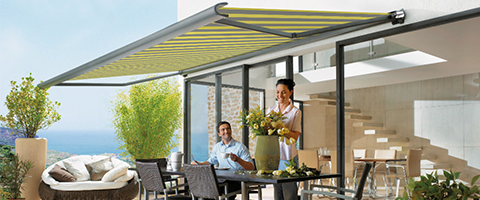 |
 Question Two: Will the awning be only used for sun protection or also when raining?
Question Two: Will the awning be only used for sun protection or also when raining?
For an awning that will be used in the rain, certain self supported awning models are definitely stronger and more suited. A key aspect is to have a minimum 14 degree pitch on the fabric cover (and ideally 20 degrees) which inevitably can mean quite a high fixing position for the awning cassette at the rear. This can be an issue with single storey buildings/extensions.Heavy bursts of rain may cause an issue with any fabric cover canopy, even with a reasonably steep pitch, and obviously stormy weather can also bring sudden high winds, which are a greater issue to self supporting fabric awnings. We do offer an awning with a manual winding mechanism to adjust the pitch as required on the fly.For defined rain use it might be better to look at the supported systems such as the Markilux Pergola or a fixed glass or polycarbonate roof canopy with an additional retractable fabric awning for sun protection when required.For more information on what systems are suitable for different weather conditions, click here.
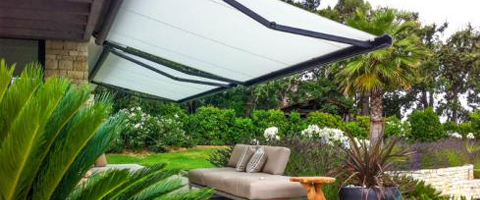 |
 Question Three: Is there an issue with wind in the proposed area?
Question Three: Is there an issue with wind in the proposed area?
Wind is the biggest enemy of self supported fabric awnings and if wind is a large factor in the proposed area then definitely consider the stronger, supported Pergola type systems, fixed glass or polycarbonate canopies or similar systems with a retractable vinyl or louvred aluminium roof and support from all sides. Many of these systems can have additional side protection products such as vertical blinds or frameless sliding glass doors. which also help deal with windier conditions.Do consider that the speed of wind at which an awning retracts is normally at the point where sitting outside is not comfortable, so the main issue is usually with larger commercial applications where weather protection needs to be more assured most of the year round.A wide range of products also help to combat wind such as pull out retractable side screens, vertical fabric blinds, adjustable louvred aluminium fencing and vertically rising glass balustrades. We can provide many products to prevent wind from one or all sides of any of the structures we sell.
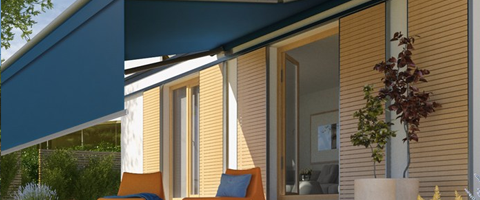 |
 Question Four: Is the building a single or double/multi storey?
Question Four: Is the building a single or double/multi storey?
Single storey buildings will nearly always present a problem, with insufficient height and fixing ability the main problems. Often the use of spreader or gutter brackets will be required, not only to give sufficient strength and support but also to place the awning cassette at a suitable height to give the pitch in the projection without having a very low front end when extended.
Single storey extensions fitted with bi folding doors opening outwards can also present an issue with the door leaves being an obstruction to the awning when extending or retracting. In some cases you can use a self supporting steel or aluminium goal post structure to enable an awning to be positioned in front of but not directly fixed to the building. Look at the Markilux Syncra frame systems for ideas on this.
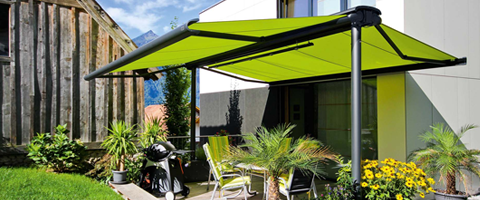 |
 Question Five: Wall bracket position?
Question Five: Wall bracket position?
Are there any issues with where the wall brackets are to be fitted? Bear in mind some awnings are only manufactured with end fixed brackets and others have some flexibility in their positioning. Larger awnings will require more than two brackets and sometimes up to eight brackets on some 14 metre wide awnings. These brackets may not be able to be positioned where there is an existing door or window aperture so check before committing. There is always a way round the problem however, with additional and extended brackets going horizontally or vertically.
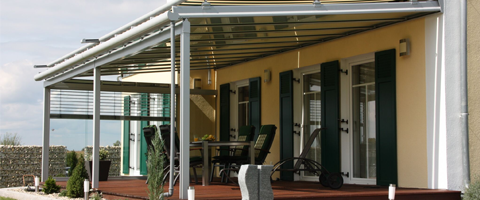 |
 Question Six: Which direction does the all face where the awning is to be located?
Question Six: Which direction does the all face where the awning is to be located?
Low lying sun may well be an issue in the Spring and Autumn for South and West facing walls, but products such as the drop down valance are a possible solution. Additional projection may also provide the solution, where the awning might go out to a far lower position than when being used for more normal use. i.e. a 4m projection being specified when 3m is required as an awning and the extra 1m can be used when shading is required. There will also be a prevailing wind direction in most gardens and outdoor areas so this needs to be potentially considered.
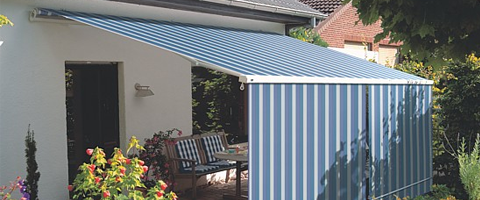 |
 Question Seven: Manual or electric operation?
Question Seven: Manual or electric operation?
Electric operation will provide far more control during daily use, and also ensure a wind sensor can be used to protect the awning if the wind ever builds up to a dangerous level whilst the awning is extended.
A simple wind sensor is possibly one of the best options to include with any electric awning to ensure safety in use.
With the electric operation also come options such as LED lighting or electric driven drop down front valances and these can all be controlled from the same handset.
Manual operation is not recommended on awnings larger than about 5m wide or 3m in projection.
Always try to use the servo assisted option for manual winding for ease of use. The standard manual operation is a winding handle with a hook on the end which hooks onto an eye protruding on the underside of the awning.
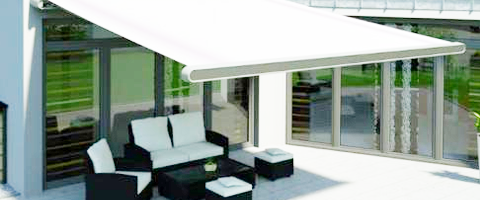 |
 Question Eight: Approximate area to cover in width and then projection from the building?
Question Eight: Approximate area to cover in width and then projection from the building?
Many higher specification awnings can be manufactured up to just under 14 metres wide, and the maximum projection for a self- supporting awning is four metres. Any larger than this and you have to start looking at systems with front supports and a framework in which the fabric is guided in for additional support.
A lot of people often require quite a large projection for sun protection but don’t have the same width available, at which point you can look at the retractable awnings with crossover arms (stretch awnings) which will project further than their width. The retractable fabric pergolas by Weinor and Markilux also can achieve this as they don’t use hinged arms in these systems, and will project out to a maximum of 6 metres!
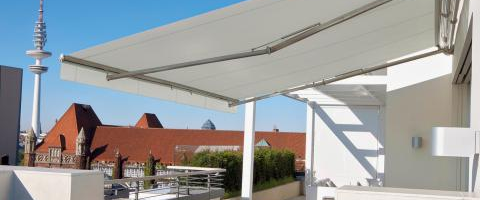 |
 Question Nine: Any specific colours required for either the cassette and framework or the fabric cover?
Question Nine: Any specific colours required for either the cassette and framework or the fabric cover?
Generally there are some very good standard colours for the higher quality awning manufacturers and popular neutral colours to help the awning cassette blend in with the architecture of your property.
It is possible to get almost any colour from the RAL chart references at extra cost. For instance, Weinor manufacture their awnings and other outdoor systems with a standard offering of 47 finished colours including some metallic and tougher paint finishes at no extra cost.
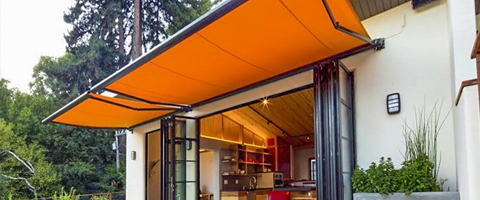 |
 Question Ten: Special brackets for single storey buildings
Question Ten: Special brackets for single storey buildings
As mentioned several times, when fitting self-supporting retractable awnings onto single storey buildings and extensions it is almost inevitable that additional steel or aluminium brackets will be required to enable a safe and secure installation. An average single storey building will have an eaves height under the soffit boards (often the bottom of the roof joists) of about 2400mm and the brickwork will stop almost at the same height which means if you were to fit anything of any weight in the brickwork around this height there would be no compression weight of bricks and therefore no support strength. With any awning which exerts forces back to the fixing points even in a light wind it would probably pull the brickwork down relatively easily.
The ‘spreader’ plates and brackets used for where there is no wall strength simply spread the forces down the wall enabling the safe fixture of large awnings. ‘Gutter’ brackets will take the forces down the wall, but also then project the awning fixing position out and upwards to be adjacent or above the rainwater guttering. The reason for this is usually to get the height at the back of the awning to enable a good pitch in the fabric cover whilst also of course getting extra projection from the awning by being further out already.
When a spreader bracket is required it is not an optional extra, it is a defined requirement to enable the installation to take place and leave a safe, usable awning system. The bracket size requirements are the same for all retractable awnings dependant on size and weight, so they are a necessary item and cost to be included, ideally along with chemical fixings rather than normal screws and rawlplugs.
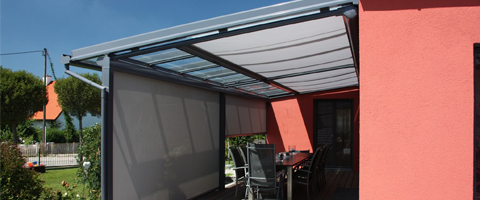 |
 Question Eleven: Which manufacturer?
Question Eleven: Which manufacturer?
Here at Samson Awnings, we choose our partners and manufacturers carefully, and we believe the best awnings in the world are probably those made by Markilux and Weinor. Both these manufacturers are German companies with long standing pedigrees and expertise in high quality, bespoke fabric awnings. Weinor have more standard colours for their cassette finishes and have more options with LED lighting if that is a requirement.
Recently we have also taken on the impressive Erhardt Markisen range, who are a designer brand from Germany which specialise in high specification awnings and glass roof systems.
The Verano awnings are manufactured in Holland and also offer high quality but perhaps without the same levels of design detail as the Markilux. We offer more standard sizes and basic specifications with Verano but all of these awnings have great guarantees and will be the best you can buy in the UK by far.
The one common factor is the design, testing and research for all the four awning ranges we offer has been carried out for years in a Northern European climate, very much the same as the UK, so all the construction and design has been based on higher wind speeds and far more aggressive weather than an awning made for the southern European sunshine only. Our awnings are far more fit for purpose for the British climate.
 |
 |
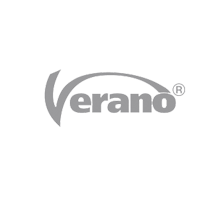 |
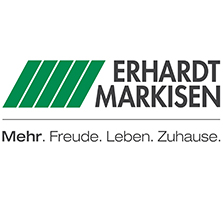 |

 Give us a call
Give us a call Send us an email
Send us an email Get a quote
Get a quote Book a survey
Book a survey






